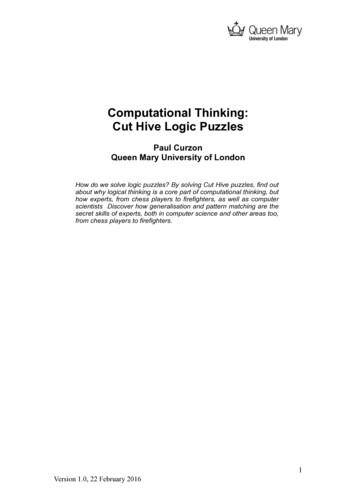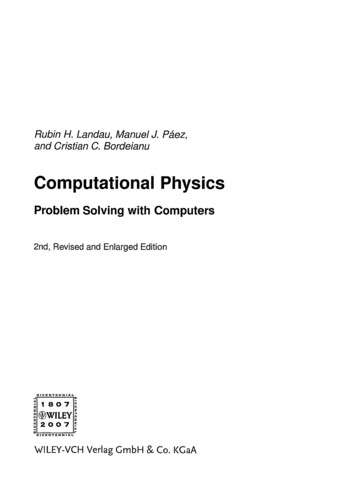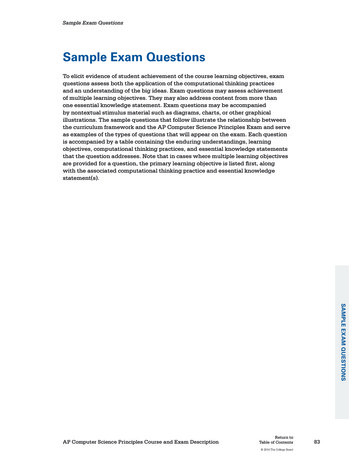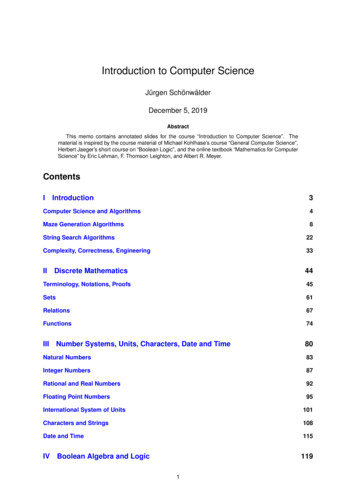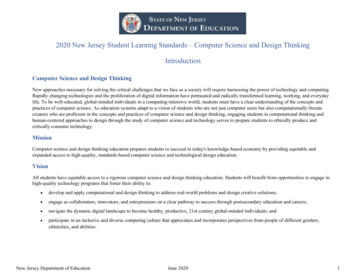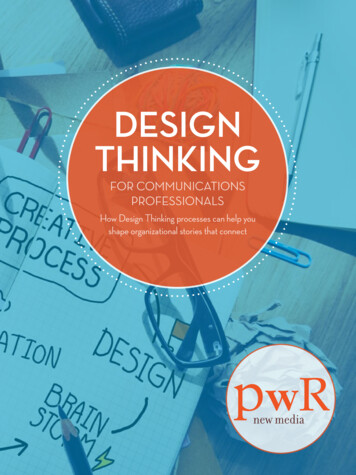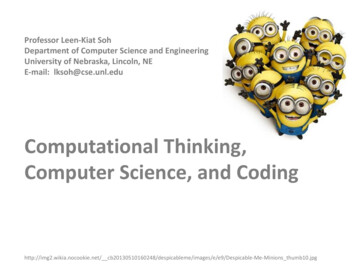
Transcription
Professor Leen-Kiat SohDepartment of Computer Science and EngineeringUniversity of Nebraska, Lincoln, NEE-mail: lksoh@cse.unl.eduComputational Thinking,Computer Science, and Codinghttp://img2.wikia.nocookie.net/ le-Me-Minions thumb10.jpg
Hmm .What om/movies/1528/despicable me minion.html
What is Computational Thinking? A way of thinking for logically and methodicallysolving problems– E.g., purposeful, describable, replicable Includes skills such as– Decomposition– Pattern Recognition– Abstraction– Generalization– Algorithm Design– Evaluation
Decomposition Breaking down a process into a set of smallersub-processes to allow us to describe,understand, or execute the process better– Dividing a task into a sequence of subtasks– Identifying elements or parts of a complex system
Decomposition
Examples of Decomposition When we taste an unfamiliar dish and identify severalingredients based on the flavor, we are decomposingthat dish into its individual ingredients When we give someone directions to our house, we aredecomposing the process of getting from one place toanother (e.g., city, interstate, etc.) When we break a course project into several steps, weare decomposing the task into smaller, moremanageable subtasks In mathematics, we can decompose a number such as256.37 as follows: 2*102 5*101 6*100 3*10-1 7*10-2
Pattern Recognition Noticing or identifying similarities or commondifferences that will help us make predictions orlead us to shortcuts– We look for patterns when we play games to decidewhen to do certain things– Based on experience, we develop shortcutsmapping problem characteristics to solution
Pattern Recognition
Examples of Pattern Recognition We look for patterns when choosing a registrar when wecheckout Drivers look for patterns in traffic to decide whether andwhen to switch lanes People look for patterns in stock prices to decide whento buy and sell Scientists look for patterns in data to derive theories andmodels We look for patterns and learn from them to avoidrepeating the same mistake– “Last time we did this, it was let’s try something different ”
Abstraction Preserving information that is relevant in acontext, and forgetting or suppressinginformation that is irrelevant in that context tosolve a problem– We use abstraction to organize things: A human is a mammal, a mammal is an animal, and so on– A “big picture” so we can reason without thinkingabout the details– Transfer learning or learning by analogyGuttag, John V. (2013-01-18). Introduction to Computation and Programming Using Python (Spring 2013 edition ed.). Cambridge,Massachusetts: The MIT Press. ISBN 9780262519632.
Abstraction
Examples of Abstraction A world map is an abstraction of the earth in termsof longitude and latitude, helping us describe thelocation and geography of a place A sign of an aisle in a store—e.g., Walmart—is anabstraction of the items available in that aisle When we write a book report, we summarize anddiscuss only the theme or key aspects of the book,it is abstraction When we tell a story or describe a movie to ourfriends, why don’t we describe every single detail ofthe story or movie?
Generalization Identifying common or shared characteristicsbetween two domains or problems such thatmodels or solutions of one could be adapted orapplied to the other– Mammals are warm blooded, give live birth, have hair,and so on. An elephant is a mammal. Therefore, it iswarm blooded, give live birth, have hair – Group project A successful because of good teamworkstrategy. Apply same good teamwork strategy to groupproject B should work too.– Deals with trends, norms, outliers, scalability
Generalization
Examples of Generalization Facebook tries to recommend ads to users based onwhat they generalize from what our friends like Google search identifies popular keywords in differentregions at different times and suggests those keywords(in autocomplete and also correction) using ageneralization-like process Amazon.com and Netflix model and categorize theircustomers, use generalization—inferencing—to predictwhat their customers are interested in, and makerecommendations accordingly When we don’t have complete information, we resort togeneralization to make decisions (sometimes incorrectly)– Think about: biases, stereotypes, superstitions
Algorithm Design Developing a step-by-step strategy for solving aproblem– An algorithm is a sequence of steps that solves aproblem Input à output Effective– Algorithmic thinking involves both creation andexecution of an algorithm
Algorithm Design
Examples of Algorithm Design When a cook writes a recipe for a dish, he or she iscreating an algorithm that others can follow to replicatethe dish When your friend writes down the instruction to get toher house, he or she is specifying a sequence of steps—that is, an algorithm—for you to follow (See Googlemaps!) When a teacher gives a set of instructions to carry out anexperiment, he or she is specifying an algorithm for youto follow to collect and analyze data When you follow an installation manual to assemble abookshelf, you are executing an algorithm
Evaluation Checking to see whether a solution is good– Algorithm correctness– Requirements (meeting constraints, designprinciples, etc.)– Performance (usability, efficiency, speed,complexity, reliability, etc.)
Evaluation
in-25-profound-comics-8847ea03819c
Examples of Evaluation When we cook, we taste our dishes and then adjustflavoring accordingly When we fold a paper airplane, we test its flight, andthen revise either the design or the “execution” to makeit fly better When we jog or bike, we keep track of our breathing,joints, etc., and decide whether to stop, go slower, or gofaster When we carry out a physics experiment, say, to find therelationship between temperature and pressure, wecheck our data, investigate why it does not match thetheory, redo our experimental setup, and recollect datapoints
So, Computational Thinking is Decomposition PatternRecognition Abstraction Generalization AlgorithmDesign EvaluationWait a minute These are thingsthat we already arecapable of oons-despicable-me-minion.html
What is Computer Science? There are many definitions.Computer Sciencehelps us practice ourcomputational thinkingbetter, faster, withlarger and morecomplex problems
What is Computer Science?Science: We learn,model, and describehow humans think,make decisions, andsolve problems 5856/Engineering: We buildcomputer solutions tosupport and automatehuman thinking, decisionmaking, problem solving.
What is Computer Programming? A process that leads from an originalformulation of a computing problem toexecutable programsCODE CODE ikipedia.org/wiki/Computer programmingCODE
Code.orghttp://code.orgFrom code.orgGo to Video
Resources Many CS & Computational Thinkingeducation/outreach resources available online National Center for Women & Information Technology(NCWIT) “in-a-box” kits http://ncwit.org Ensemble, a Portal for Computing Educatorshttp://www.computingportal.org CS Education Week http://www.csedweek.org Google’s Computer Science for High School (CS4HS)http://cs4hs.com Google’s Exploring Computational exploring-computationalthinking/ Code.org http://code.org
CS Unpluggedhttp://csunplugged.org “CS Unplugged isa collection offree learningactivities thatteach ComputerScience throughengaging gamesand puzzles thatuse cards, string,crayons and lotsof runningaround.”“The activitiesintroduce studentsto underlyingconcepts such asbinary numbers,algorithms and datacompression,separated from thedistractions andtechnical details weusually see withcomputers.”“CS Unplugged issuitable for peopleof all ages, fromelementary schoolto seniors, and frommany countries andbackgrounds.Unplugged has beenused around theworld for overfifteen years, inclassrooms, sciencecenters, homes, andeven for holidayevents in a park! ”30
CS Unpluggedhttp://csunplugged.orgCreated by Tim Bell, Ian H. Witten, and Mike Fellows, and illustratedby Matt Powellgo31
CS UnpluggedAs NCWIT’s Computer Science-in-a-Box: Unplug Your -science-box-unplug-your-curriculum) Examples– Magic card show – error detection– Treasure island – finite state machines– Sorting game – sorting networks32
Finally “Computational thinking is a fundamentalskill for everyone, not just for computerscientists. To reading, writing, andarithmetic, we should add computationalthinking to every child’s analytical ability.” –Jeannette Wing, CACM 2006
Finally Computational Thinking is Conceptualizing, not programming– Computer Science is not just computer programming Fundamental, not rote skill– A skill needed by everyone to function A way that humans, not computers, think– Humans are clever and creative; computers takeinstructions from humans Ideas, not artifacts– Ideas give birth to artifacts It’s for everyone– Not just for computer scientist; but for everyone34
Special Bond:Computational Thinking and CS Articulation of computational thinking skillsand processes into reusable computerprograms (e.g., instructing machines to dopattern recognition) via coding makes us moreaware and attentive of computational thinking and more efficient and effective in practicingcomputational thinking in learning, problemsolving, etc.35
Flavors of Computational Thinking Denning, P. (2017). Remaining Trouble Spots with Computational Thinking, Communications of the ACM, 60(6):33-39.36
References http://www.google.com/edu/computational-thinking Paul Curzon’s “So What is Computational Thinking” Jeannette M. Wing’s “Computational Thinking”,Communications of the ACM, March 2006, pp. 33-35 https://en.wikipedia.org/wiki/Computer science
“It's an energy field createdby all living things. It surrounds us andpenetrates us; it binds the galaxytogether.”Obi-Wan Kenobi introduced Luke Skywalker and most of us to theForce for the first time in Star Wars: A New Hope
“It's a skill practiced by all livingthings. It surrounds us andpenetrates us; it binds problemsolving (and learning, discovery, )together.”Leen-Kiat Soh on the fundamentality of Computational Thinking.
“May computational thinkingbe with 2-4fe6-a4203c3c26dd2953.jpg. CB289161999 SL300 .jpg
Articulation of computational thinking skills and processes into reusable computer programs (e.g., instructing machines to do pattern recognition) via codingmakes us more aware and attentive of computational thinking and moreefficient and effective in practicing computational thi
